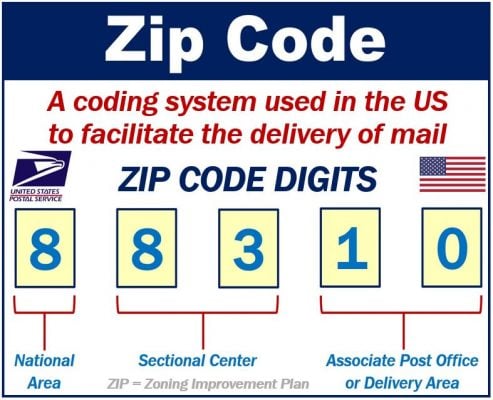The zip code is a system the United States Postal Service uses to identify a location and route the mail to that specific location. Zip stands for Zoning Improvement Plan.
Originally, the US Post Office used a 5-digit zip code. It subsequently expanded it to nine digits. With nine digits, it can carry out a more detailed identification.
Even though the 5-digit zip code is still enough for sending postal items, the 9-digit code is used mainly for businesses. Businesses can get a discount if they use the 9-digit code.
The US Post Office says the following about its zip code system:
“During World War II, thousands of experienced postal employees left to serve with the military. To offset the loss, in May 1943 the Post Office Department began a zoning address system in 124 of the largest cities.”
“Under this system, delivery units or zones were identified by one or two numbers between the city and state — for example, Birmingham 7, Alabama — so that mail could be separated by employees who did not have detailed scheme knowledge.”
“Twenty years later, the Department implemented an even farther-reaching plan, the Zoning Improvement Plan (ZIP) Code.”
This US Postal Service web page helps businesses find zip codes. There are several ways you can access this information.

Zip code – what do digits represent?
The first digit generally represents a group of US states. The second and third digits determine the central mail processing facility that processes and sorts the mail. We also call this facility the ‘sec center’ (sectional center facility).
All letters and parcels with the same first three digits go to the same sec center. The sec center subsequently sorts them according to the last two digits, after which they go to local post offices.
For example, let’s look at the zip code 88310. The first digit – 8 – represents the national area. ‘Eight’ covers Arizona, Colorado, Idaho, New Mexico, Nevada, Utah, and Wyoming.
The next two digits – 83 – represent the Sec Center. The last two digits – 10 – represent the delivery area or associate post office.
Zip code equivalents in other countries
In the UK, the post office uses a system it calls the ‘post code,’ which is alphanumeric. Alphanumeric means it consists of numbers and letters. In the British System, for domestic properties, a single postcode may cover up to one-hundred properties in contiguous proximity.
We can write the term as one word – postcode – or two words – post code.
Ireland, which has the Eircode, provides a 7-character alphanumerical unique code for each individual address.
India has had PIN codes since 1972. PIN stands for Postal Index Number. It is a six-digit code. India has nine different postal zones.
The Canadian postal code consists of six characters, which are alphanumeric.
Australian post codes consist of four numbers. You have to write them after the name of the town, city, or suburb, and the state or territory.
In New Zealand, post codes consist of four digits.
While Americans say zip code, most other countries say post code, postal code, or pin code.
